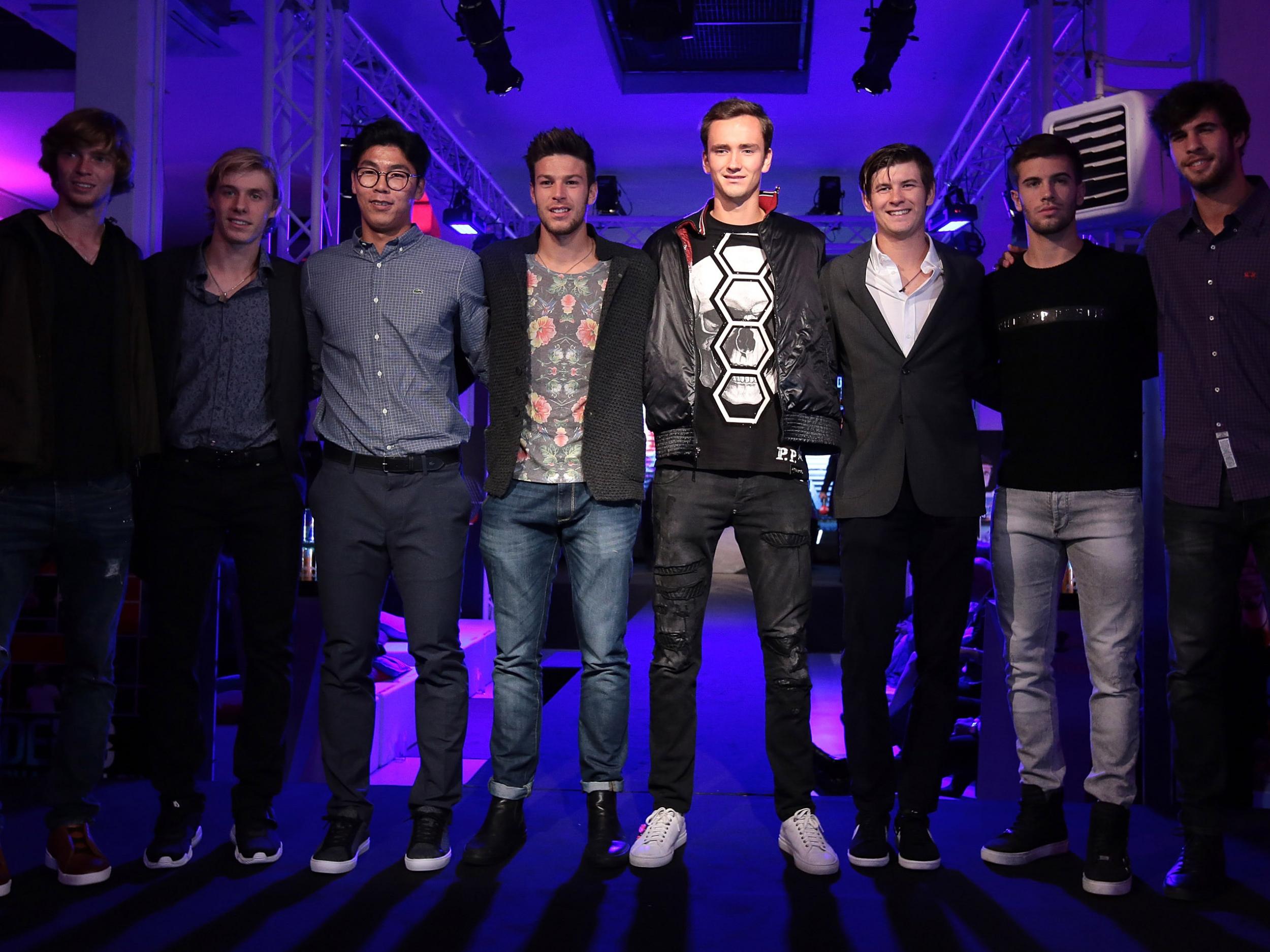Aside from sexism and crassness, NextGen ATP finals offer glimpse of the future of tennis and evolution of its rules
The eight best under-21-year-olds on the planet battle it out in Milan

It was meant to celebrate the emergence of a new generation of exciting young players but the inaugural NextGen ATP Finals in Milan got off to the worst possible start with a draw ceremony which drew widespread criticism for its sexism and crassness. It prompted an apology for what organisers admitted was the ceremony’s “poor taste”.
The eight participating players, the best in the world aged 21 and under, were each asked to choose a female model to escort them down a catwalk. The models then revealed a letter to show in which round-robin group the player would be competing. One model took off her jacket to reveal a letter marked on her back and another raised her dress to reveal a letter written on her thigh.
Some of the players looked uncomfortable during the ceremony and Judy Murray and Amelie Mauresmo were among those to voice their disgust on Twitter. Murray said the ceremony was “awful” and Mauresmo called it a “disgrace”.
The ceremony was conducted on Sunday at a party organised by Red Bull. Association of Tennis Professionals officials had been unaware of what exactly had been planned.
Red Bull and the ATP apologised on Monday in a joint statement. “ATP and Red Bull apologise for the offence caused by the draw ceremony for the Next Gen ATP Finals,” they said.
“The intention was to integrate Milan’s rich heritage as one of the fashion capitals of the world. However, our execution of the proceedings was in poor taste and unacceptable. We deeply regret this and will ensure that there is no repeat of anything like it in the future.”
The controversy over the ceremony diverted attention from what will be a ground-breaking event, which will start on Tuesday. It is the first at this level to bring together 21-and-under players, who in recent years have had increasing difficulty making their senior breakthrough after leaving the junior ranks. It is also trialling a number of innovations designed to make the sport more appealing to the public.
As the modern game has become increasingly physical, the average age of the top players has become older. The idea of a 17-year-old being able to win a Grand Slam title, as Boris Becker did at Wimbledon 32 years ago, has become all but unthinkable today.
Nevertheless as the dominant men of recent years – Roger Federer, Rafael Nadal, Novak Djokovic, Andy Murray and Stan Wawrinka – have all moved into their thirties and on occasions struggled with their fitness, a new wave of players has been emerging. The most successful of the new generation has been Alexander Zverev, though the 20-year-old German has been so successful that he withdrew from this week’s event in order to concentrate on next week’s Nitto ATP Finals at the O2 Arena in London, for which he also qualified.
Italy’s Gianluigi Quinzi, the world No 306, who has been given a wild card into the tournament, is the only player in this week’s field who is not ranked in the world’s top 100. The highest ranked player is 20-year-old Andrey Rublev, the world No 37. He is one of three Russians alongside Karen Khachanov and Daniil Medvedev.
Canada’s Denis Shapovalov, who beat Nadal in the summer and reached the fourth round of the US Open, is the youngest player at the age of 18, while the 20-year-old Croatian, Borna Coric, is arguably the most experienced, having made his debut on the main tour four years ago. The field is completed by South Korea’s Hyeon Chung and the American Jared Donaldson.
Eyes will be on the innovations as much as the players. Following the lead of sports like cricket, which has successfully introduced shortened new formats, the ATP is experimenting this week with a new scoring format which it hopes will generate more excitement.
Matches are being played over the best of five sets, with each set won by the first player to win four games. At deuce in each game a deciding point will be played and at 3-3 in each set a tie-break will be played. On-court clocks will enforce the 25-second rule between points and there will be no “lets” on serves: if a serve hits the top of the net and then lands in the court play will continue.
There will be no line judges and no challenges as all line calls will be decided by Hawk-Eye cameras. The umpire will be the only official on court, with foot faults determined by an off-court official. Players will be able to talk to their coaches via headsets at the end of each set and there will be shorter pre-match warm-ups.
Chris Kermode, the ATP’s executive chairman and president, said: "We're excited to be bringing something new to the table with this event. The sports and entertainment landscape is changing rapidly, as are the ways in which fans are consuming our sport.
“This event is not only about the next generation of players, but also about the next generation of fans. We've created this new tournament precisely to allow us to look at some potential new elements, in a high-profile environment.”
The winners and runner-up in both of the round-robin groups will go through to the knock-out stages, with semi-finals followed by a final.
Group A: Andrey Rublev (Russia), Denis Shapovalov (Canada), Hyeon Chung (South Korea), Gianluigi Quinzi (Italy).
Group B: Karen Khachanov (Russia), Borna Coric (Croatia), Jared Donaldson (US), Daniil Medvedev (Russia).
Subscribe to Independent Premium to bookmark this article
Want to bookmark your favourite articles and stories to read or reference later? Start your Independent Premium subscription today.

Join our commenting forum
Join thought-provoking conversations, follow other Independent readers and see their replies